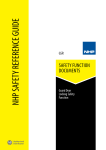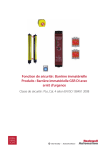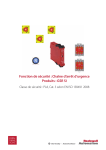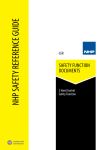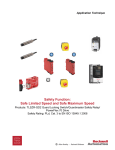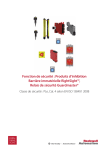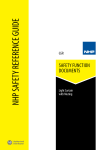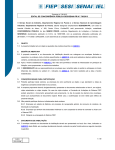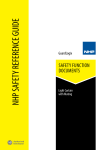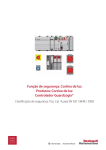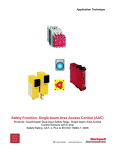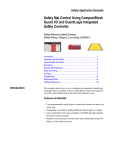Download Light Curtain with E-Stop Safety Function
Transcript
NHP SAFETY REFERENCE GUIDE GSR SAFETY FUNCTION DOCUMENTS Light Curtain with E-Stop Safety Function Documents: GSR Safety Function: Light Curtain Product: GSR DI Light Curtain with E-Stop Safety Rating: PLe, Cat. 4 to EN ISO 13849.1 2008 Table of Contents: Introduction 6-51 Important User Information 6-51 Safety Function Realization 6-52 General Safety Information 6-53 Setup and Wiring 6-55 Configuration 6-56 Calculation of the Performance Level 6-57 Verification and Validation Plan 6-61 Additional Resources 6-63 NHP Safety Reference Guide > Safety Function Documents: GSR 6B-63 Safety Function Documents: GSR Safety Function: Light Curtain Product: GSR DI Light Curtain with E-Stop Safety Rating: PLe, Cat. 4 to EN ISO 13849.1 2008 Introduction Important User Information This Safety Function application note explains how to wire and configure a GSR DI dual input Safety Relay to monitor both an E-Stop and GuardShield™ Light Curtain. When an object intrudes into the light curtain’s field of view, the E-Stop is actuated or a fault is detected in the monitoring circuit the GSR DI Safety Relay de-energizes the final control devices, in this case a pair of 100S safety contactors. Solid state equipment has operational characteristics differing from those of electromechanical equipment. Safety Guidelines for the Application, Installation and Maintenance of Solid State Controls (publication SGI-1.1 available from your local Rockwell Automation® sales office or online at http://www. rockwellautomation.com/literature) describes some important differences between solid state equipment and hard-wired electromechanical devices. E-Stops are required in most applications. Safety Systems requiring both a sensing device, like a light curtain, and E-Stop combination are common. The DI, with its dual inputs makes this easy to implement in a single Safety Relay. Because of this difference, and also because of the wide variety of uses for solid state equipment, all persons responsible for applying this equipment must satisfy themselves that each intended application of this equipment is acceptable. In no event will Rockwell Automation, Inc. be responsible or liable for indirect or consequential damages resulting from the use or application of this equipment. The examples and diagrams in this manual are included solely for illustrative purposes. Because of the many variables and requirements associated with any particular installation, Rockwell Automation, Inc. cannot assume responsibility or liability for actual use based on the examples and diagrams. No patent liability is assumed by Rockwell Automation, Inc. with respect to use of information, circuits, equipment, or software described in this manual. Reproduction of the contents of this manual, in whole or in part, without written permission of Rockwell Automation, Inc., is prohibited. NHP Safety Reference Guide > Safety Function Documents: GSR 6B-64 Safety Function Documents: GSR Safety Function: Light Curtain Product: GSR DI Light Curtain with E-Stop Safety Rating: PLe, Cat. 4 to EN ISO 13849.1 2008 Safety Function Realization: Risk Assessment Safety Functional Requirements The required performance level is the result of a risk assessment and refers to the amount of the risk reduction to be carried out by the safety-related parts of the control system. In this Application Note the performance level required by the Risk Assessment is (PLr) PLe, Category 4 for each Safety Function. A safety system that achieves PLe, Category 4, or higher, can be considered control reliable. The light curtain must be installed at a distance from the hazardous motion such that a user cannot reach the hazard before the motion has stopped. This distance is called the Safety Distance and will be addressed later in this Application Note. An object intruding into the light curtain field of view will stop the hazardous motion by removal of power to the motor. The system cannot be reset while an object is in the field of view. Once the object has left the field of view, pressing and releasing the Reset button (a separate action) will resume the hazardous motion. Pressing the E-Stop button will stop the hazardous motion by removal of power to the motor. Releasing the E-Stop will not restart the hazardous motion. Pressing the reset button after the E-Stop has been reset and all faults are cleared will result in the restoration of the hazardous motion. Faults at the light curtain, wiring or Safety Relay will be detected before the next safety demand. The safety system described in this Application Note is capable of connecting and interrupting power to motors rated up to 9A, 600VAC. The Safety Functions will each meet the requirements for Performance Level “e”, Category 4, (PLd, Cat. 4), per ISO 13849-1, and SIL3 per IEC 62061, and control reliable operation per ANSI B11.19 Light Curtain Safety Function Part of the risk reduction process is to determine the safety functions of the machine. The Safety System described in this application has two Safety Functions: 1.Emergency stop initiated by intrusion into the light curtain’s field of view, point of operation control. 2.Emergency stop initiated by actuation of an emergency push button. This system executes a Stop Category 0 stop. Power is removed and the motion coasts to a stop. NHP Safety Reference Guide > Safety Function Documents: GSR 6B-65 Safety Function Documents: GSR Safety Function: Light Curtain Product: GSR DI Light Curtain with E-Stop Safety Rating: PLe, Cat. 4 to EN ISO 13849.1 2008 Throughout this manual, when necessary, we use notes to make you aware of safety considerations. Bill of Material Cat. No. Description GuardShield™ Safety Light Curtain, Res 14 mm, Pt Ht 640 440L-P4JL0640YD mm, 64 Beams, Integrated Laser Alignment DC Micro (M12), Female, Straight, 4-Pin, PVC Cable, 889D-F4AC-2 Yellow, Unshielded, 22AWG, IEC Color Coded, No Connector, 2 meter (6.56 feet) DC Micro (M12), Female, Straight, 8-Pin, PVC Cable, 889D-F8AB-2 Yellow, Unshielded, 24AWG, IEC Color Coded, No Connector, 2 meter (6.56 feet) 800F Push Button - Metal, Guarded, Blue, R, Metal Latch Mount, 800FM-G611MX10 1 N.O. Contact(s), 0 N.C. Contact(s), Standard, Standard Pack (Qty. 1) 800F 1-Hole Enclosure E-Stop Station, Plastic, PG, Twist800F-1YP3 to-Release 40mm, Non-Illuminated, 2 N.C. Guardmaster® Safety Relay, 2 Dual Channel Universal 440R-D22R2 Inputs, 1 N.C. Solid State Auxiliary Outputs 100S-C09ZJ23C MCS 100S-C Safety Contactor, 9A, 24V DC Quantity 1 1 1 1 1 1 2 Setup and Wiring For detailed information on installing and wiring, refer to the product manuals listed in the Additional Resources. System Overview General Safety Information Contact Rockwell Automation to find out more about our safety risk assessment services. When an object intrudes into the light curtain field of view the light curtain switches off its two PNP outputs (OSSDs). The Safety Relay responds to this by opening its two output relays. This removes +24V from the coils of the two Safety Contactors whose contacts open removing power to the motor. The motor will coast to a stop (Stop Category 0). The light curtain’s OSSD outputs turn on once its field of view is no longer interrupted. The light curtain monitors its internal circuitry and its OSSD outputs for faults. When a fault in the internal circuitry or an output is detected, the Light curtain responds by turning off its OSSD outputs. Functional Safety Description When an object intrudes into the light curtain field of view the light curtain hazardous motion is stopped and prevented from restarting starting until the light curtain field of view is restored. The GSR DI’s pulse test outputs S11 and S21 are run through the two NC contacts of the E-Stop to inputs S12 and S22 respectively. When the E-Stop is pressed these circuits are interrupted. GSR DI responds by turning open its safety contacts and removes power from the 100S contactor coils. This removes +24V from the coils of the two 100S contactors whose contacts open, removing power to the motor. The motor will coast to a stop (Stop Category 0). Likewise when the E-Stop is pressed the hazardous motion is stopped and prevented from restarting starting until the E-Stop is released. NHP Safety Reference Guide > Safety Function Documents: GSR 6B-66 Safety Function Documents: GSR Safety Function: Light Curtain Product: GSR DI Light Curtain with E-Stop Safety Rating: PLe, Cat. 4 to EN ISO 13849.1 2008 The GSR DI monitors the E-Stop circuit for faults. Loose wires, shorts to 24V, shorts to GND, contacts failed closed and cross faults will be detected. When a fault is detected the GSR DI responds by turning opening its safety contacts and removes power from the 100S contactor coils. This removes +24V from the coils of the two 100S contactors whose contacts open, removing power to the motor. The motor will coast to a stop (Stop Category 0). Ds = K x (Ts + Tc + Tr – Tbm) + Dpf. Two NC contacts, one from each of the safety contactors, are connected as part of the reset circuit. The Safety Relay can be reset only if both safety contactors are in a proper de-energized state. Dpf : the distance a “Standard” hand could possibly move through the light curtain before it is detected. This is a fixed value based on the light curtain resolution. The Safety Relay cannot be reset while the E-Stop remains actuated or while the light curtain OSSD outputs are off. Once the E-Stop has been released and/or the light curtain OSSD outputs turn on pressing and releasing the Reset button (a separate, deliberate action) will resume the hazardous motion. The Reset button must be pressed for more than a quarter second and less than three seconds. A shorter press will be ignored; a longer press will be ignored. K : The “Standard” hand speed of 63 inches per second Ts: The stop time of the machine Tc: The response time of the safety system Tr:The response time of the presence sensing device Tbm: Additional time allowed for the brake monitor (if any) to compensate for variations in normal stopping time. In this Application Note the values are: K: 63 inches per second Ts: 900ms Tc: 50ms ( 35ms,DI plus 15ms K1/K2) Tr: 20ms Tbm: 0 – none used in this application Dpf: 23.8mm (I inch) The Safety Relay checks itself for internal faults, faults on its inputs and wiring and monitors the safety contactors via the contactors NC contacts in the reset circuit. DS = (63 x .97) + 1 = 62.11 inches. No single fault will result in the safety system failing to perform its safety function. A single fault will be detected before the next demand on the safety system. The system cannot be reset until the fault is corrected. The same calculation using EN ISO 13855 Installation Refer to the installation instruction and user manuals for guidance on installing and maintaining the different parts of this system. A safety light curtain provides no physical barrier between personnel and the hazardous motion. The safety light curtain must be installed at a sufficient distance from the hazardous motion to ensure that an operator putting a hand through the light curtain cannot reach the hazard before it has stopped. This distance is referred to as the Safety Distance. The Safety Distance (Ds) required varies from installation to installation and, therefore, must be calculated for each specific application. This Application Note will use the ANSI formula: The light curtain must not be mounted closer than 62.11 inches from the hazardous motion being guarded against. S = (K x T) + C S: Minimum distance , in millimeters (mm) K: Is a parameter, in millimeters per second (mm/s), derived from data on approach speeds of the bodyor parts of the body T: is the overall stopping performance in seconds. C: is the intrusion distance in mm In this Application Note the values are: K = 1600mm per second T = 970ms (Machine Stopping Time + Reaction time of LC + Reaction time of DI and contactors K1/K2 C = 8(d-14) but not less than 0 where d is the resolution of the light curtain S = 1600 x .970 + 8(14 -14) The light curtain must not be mounted closer than 1552mm (approx. 61 in) from the hazardous motion being guarded against. NHP Safety Reference Guide > Safety Function Documents: GSR 6B-67 Safety Function Documents: GSR Safety Function: Light Curtain Product: GSR DI Light Curtain with E-Stop Safety Rating: PLe, Cat. 4 to EN ISO 13849.1 2008 Electrical Schematic NHP Safety Reference Guide > Safety Function Documents: GSR 6B-68 Safety Function Documents: GSR Safety Function: Light Curtain Product: GSR DI Light Curtain with E-Stop Safety Rating: PLe, Cat. 4 to EN ISO 13849.1 2008 Configurations The 440L Light curtain uses dip switches to configure it for different applications. This application uses the Default Settings. No switch changes are necessary. Receiver - Factory Settings Switch Switch Function Default Setting 1 Mode Activation - Combination activates one of the following modes: Guard Only, Start Interlock, Restart Interlock ON 3 MPCE: Monitoring Disable ON Disabled 4 Fixed Blanking Activate OFF Disabled 5 Floating Blanking Activate - Single Beam OFF 6 Floating Blanking Activate - Two Beams OFF 7 Set Beam Coding OFF 8 Not Used OFF 2 ON Description Guard Only Switches 5&6 cannot be activated “On” at the same time Disabled Transmitter - Factory Settings Switch Switch Function Default Setting 1 Set Beam Coding OFF 2 Machine Test Signal OFF Description Disabled OFF: Signal High Active–No connection or connect normally open ON: Signal Low Active–Connect N/C The 440R-D22R2 Safety Relay (DI) must be configured LOGIC 2, (L12 OR (IN 1 AND IN 2). Configure the Safety Relay for LOGIC 2 as per the Installation Instructions, publication 10000175129 ver. 00. NHP Safety Reference Guide > Safety Function Documents: GSR 6B-69 Safety Function Documents: GSR Safety Function: Light Curtain Product: GSR DI Light Curtain with E-Stop Safety Rating: PLe, Cat. 4 to EN ISO 13849.1 2008 Calculation of the Performance Level Performance Level required from the Risk Assessment is Performance Level d (PLd). When properly implemented, the Safety Functions described here can achieve a PLe according to EN ISO 13849-1 2008 as calculated using the SISTEMA Tool. Calculations are based on each Safety Function being operated once an hour, 24 hours a day, 365 days a year for a total of 8,760 operations a year. Bear in mind that the 100S contactors are used in both safety functions so in their calculations are based on 17,520 operations per year. The overall safety project Performance Level is: This Safety System includes two Safety Functions, a Light Curtain Safety Function and an E-Stop Safety Function. The two Safety Functions can be represented in block diagrams. NHP Safety Reference Guide > Safety Function Documents: GSR 6B-70 Safety Function Documents: GSR Safety Function: Light Curtain Product: GSR DI Light Curtain with E-Stop Safety Rating: PLe, Cat. 4 to EN ISO 13849.1 2008 Calculation of the Performance Level cont. Light Curtain Safety Function Subsystem 1 modeled as below. Light Curtain safety Function Subsystem 2 Light Curtain safety Function Subsystem 3 NHP Safety Reference Guide > Safety Function Documents: GSR 6B-71 Safety Function Documents: GSR Safety Function: Light Curtain Product: GSR DI Light Curtain with E-Stop Safety Rating: PLe, Cat. 4 to EN ISO 13849.1 2008 Calculation of the Performance Level cont. The E-Stop safety function is represented below: E-Stop Safety Function Subsystem 1 E-Stop Safety Function Subsystem 2 NHP Safety Reference Guide > Safety Function Documents: GSR 6B-72 Safety Function Documents: GSR Safety Function: Light Curtain Product: GSR DI Light Curtain with E-Stop Safety Rating: PLe, Cat. 4 to EN ISO 13849.1 2008 Calculation of the Performance Level cont. E-Stop safety Function Subsystem 3 Note that the E-Stop and Safety Contactors data includes MTTFd, DCavg, and CCF data. This is because these are electromechanical devices. Electromechanical devices functional safety evaluations include how frequently they are operated, whether they are effectively monitored for faults and properly specified and installed. SISTEMA calculates the MTTFd using B10d data provided for the contactors along with the estimated frequency of use entered during the creation of the SISTEMA project. The DCavg (99%) for the contactors was selected from the Output Device table of EN ISO 13849-1 Annex E. “Direct Monitoring”. The DCavg (99%) for the E-Stop was selected from the Input Device table of EN ISO 13849-1 Annex E. “Cross Monitoring”. The (CCF) value is generated using the scoring process outlined in Annex F of ISO 13849-1. The complete CCF scoring process must be done when actually implementing an application. A minimum score of 65 points must be achieved. Verification and Validation Plan safety system design and development process. ISO/EN 13849-2 sets the requirements for verification and validation. It calls for a documented plan to confirm all the Safety Functional Requirements have been met. Verification is an analysis of the resulting safety control system. The Performance Level (PL) of the safety control system is calculated to confirm it meets the Required Performance Level (PLr) specified. The SISTEMA software tool is typically utilized to perform the calculations and assist with satisfying the requirements of ISO 13849-1. Validation is a functional test of the safety control system to demonstrate that it meets the specified requirements of the safety function. The safety control system is tested to confirm all of the safety related outputs respond appropriately to their corresponding safety related inputs. The functional test should include normal operating conditions in addition to potential fault inject of failure modes. A checklist is typically used to document the validation of the safety control system. Prior to validating the GSR Safety Relay system, it is necessary to confirm the GSR Relay has been wired and configured in accordance with the Installation Instructions. NHP Safety Reference Guide > Safety Function Documents: GSR 6B-73 Safety Function Documents: GSR Safety Function: Light Curtain Product: GSR DI Light Curtain with E-Stop Safety Rating: PLe, Cat. 4 to EN ISO 13849.1 2008 GSR Light Curtain Safety Function Verification and Validation Checklist GENERAL MACHINERY INFORMATION Machine Name / Model Number Machine Serial Number Customer Name Test Date Tester Name(s) Schematic Drawing Number Guardmaster Safety Relay Model Safety Wiring and Relay Configuration Verification Test Step Verification Pass/Fail Changes/Modifications Visually inspect the safety relay circuit is wired as documented in the schematics. Visually inspect the Light Curtain is configured as documented. Visually inspect the safety relay rotary switch settings are correct as documented. Normal Operation Verification - The safety relay system properly responds to all normal Start, Stop, Estop and Reset Commands Test Step Verification Pass/Fail Changes/Modifications Initiate a Start Command. Both contactors should energize for a normal machine run condition. Verify proper machine status indication and safety relay LED indication. Initiate a Stop Command. Both contactors should de-energize for a normal machine Stop condition. Verify proper machine status indication and safety relay LED indication. While Running, interrupt the light curtain. Both contactors should de-energize and open for a normal safe condition. Verify proper machine status indication and safety relay LED indication. Repeat for all light curtains. While Stopped, interrupt the light curtain, initiate a Start Command. Both contactors should remain de-energized and open for a normal safe condition. Verify proper machine status indication and safety relay LED indication. Initiate Reset Command. Both contactors should remain de-energized. Verify proper machine status indication and safety relay LED indication. Abnormal Operation Verification - The Safety Relay system properly responds to all foreseeable faults with corresponding diagnostics. Light Curtain Input Tests Test Step Validation Pass/Fail Changes/Modifications While Running, remove the Channel 1 wire from the safety relay. Both contactors should de-energize. Verify proper machine status indication and safety relay LED indication. Repeat for Channel 2. While Running, short the Channel 1 of the safety relay to +24VDC. Both contactors should de-energize. Verify proper machine status indication and safety relay LED indication. Repeat for Channel 2. While Running, short the Channel 1 of the safety relay to (-) 0VDC. Both contactors should de-energize. Verify proper machine status indication and safety relay LED indication. Repeat for Channel 2. While Running, short Channels 1 & 2 of the safety relay. Both contactors should de-energize. Verify proper machine status indication and safety relay LED indication. GSR Logic Solver Tests Test Step Validation Pass/Fail Changes/Modifications While Running, remove the single wire safety connection between two adjoining safety relays in the system. All contactors should de-energize. Verify proper machine status indication and safety relay LED indication. Repeat for all safety connections. This test is not applicable for single relay circuits. While Running, turn the logic rotary switch on the safety relay. All contactors should remain de-energized. Verify proper machine status indication and safety relay LED indication. Repeat for all safety relays in the system. Safety Contactor Output Tests Test Step Validation Pass/Fail Changes/Modifications While Running, remove the contactor feedback from the safety relay. All contactors should remain energized. Initiate a Stop Command followed by a Reset Command. The relay should not restart or reset. Verify proper machine status indication and safety relay LED indication. NHP Safety Reference Guide > Safety Function Documents: GSR 6B-74 Safety Function Documents: GSR Safety Function: Light Curtain Product: GSR DI Light Curtain with E-Stop Safety Rating: PLe, Cat. 4 to EN ISO 13849.1 2008 GSR Light Curtain Safety Function Verification and Validation Checklist cont. GENERAL MACHINERY INFORMATION Machine Name / Model Number Machine Serial Number Customer Name Test Date Tester Name(s) Schematic Drawing Number Guardmaster Safety Relay Model Safety Wiring and Relay Configuration Verification Test Step Verification Pass/Fail Changes/Modifications Visually inspect the safety relay circuit is wired as documented in the schematics. Visually inspect the Light Curtain is configured as documented. Visually inspect the safety relay rotary switch settings are correct as documented. Normal Operation Verification - The safety relay system properly responds to all normal Start, Stop, Estop and Reset Commands Test Step Verification Pass/Fail Changes/Modifications Initiate a Start Command. Both contactors should energize for a normal machine run condition. Verify proper machine status indication and safety relay LED indication. Initiate a Stop Command. Both contactors should de-energize for a normal machine Stop condition. Verify proper machine status indication and safety relay LED indication. While Running, interrupt the light curtain. Both contactors should de-energize and open for a normal safe condition. Verify proper machine status indication and safety relay LED indication. Repeat for all light curtains. While Stopped, interrupt the light curtain, initiate a Start Command. Both contactors should remain de-energized and open for a normal safe condition. Verify proper machine status indication and safety relay LED indication. Initiate Reset Command. Both contactors should remain de-energized. Verify proper machine status indication and safety relay LED indication. Abnormal Operation Verification - The Safety Relay system properly responds to all foreseeable faults with corresponding diagnostics. Light Curtain Input Tests Test Step Validation Pass/Fail Changes/Modifications Pass/Fail Changes/Modifications Pass/Fail Changes/Modifications While Running, remove the Channel 1 wire from the safety relay. Both contactors should de-energize. Verify proper machine status indication and safety relay LED indication. Repeat for Channel 2. While Running, short the Channel 1 of the safety relay to +24VDC. Both contactors should de-energize. Verify proper machine status indication and safety relay LED indication. Repeat for Channel 2. While Running, short the Channel 1 of the safety relay to (-) 0VDC. Both contactors should de-energize. Verify proper machine status indication and safety relay LED indication. Repeat for Channel 2. While Running, short Channels 1 & 2 of the safety relay. Both contactors should de-energize. Verify proper machine status indication and safety relay LED indication. GSR Logic Solver Tests Test Step Validation While Running, remove the single wire safety connection between two adjoining safety relays in the system. All contactors should de-energize. Verify proper machine status indication and safety relay LED indication. Repeat for all safety connections. This test is not applicable for single relay circuits. While Running, turn the logic rotary switch on the safety relay. All contactors should remain de-energized. Verify proper machine status indication and safety relay LED indication. Repeat for all safety relays in the system. Safety Contactor Output Tests Test Step Validation While Running, remove the contactor feedback from the safety relay. All contactors should remain energized. Initiate a Stop Command followed by a Reset Command. The relay should not restart or reset. Verify proper machine status indication and safety relay LED indication. NHP Safety Reference Guide > Safety Function Documents: GSR 6B-75 Safety Function Documents: GSR Safety Function: Light Curtain Product: GSR DI Light Curtain with E-Stop Safety Rating: PLe, Cat. 4 to EN ISO 13849.1 2008 Additional Resources For more information about the products used in this example refer to these resources. Document Pub. No. Description Guard Locking Switch Installation Instructions 440G-IN007 How to install, commission, operate and maintain the 440G-TZS21UPRH Guardmaster Safety Relay Installation Instructions 10000175129 How to install, commission, operate and maintain the 440R-D22R2 Safety Relays Guardmaster Safety Relay Troubleshooting Guide 440R-TG002 How to troubleshoot the 440RD22R2 Safety Relays Guardmaster Expansion Relay Installation Instructions 440R-IN045 How to install, commission, operate and maintain the 440R-EM4R2D Expansion Relay Guardmaster Expansion Relay Troubleshooting Guide 440R-TG001 How to install, commission, operate and maintain the 440R-EM4R2D Expansion Relay Safety Products Catalog S117-CA001A Overview of Safety products, product specifications, and application examples GuardShield Type 4 User Manual 440L-UM003 How to install, operate, and maintain the 440L Safety Light Curtains Next Generation Guardmaster Safety Relays SAFETY-WD001 Functional descriptions, guidance, and wiring for Safety Relays Heavy Duty Guard Interlock Switch Installation Instructions 440K-IN008 How to install, configure, commission, operate, and maintain MT-GD2 Interlock Switches Trojan T15 Interlock Switch Installation Instructions 440K-IN003 How to install, configure, commission, operate, and maintain Trojan T15 Interlock Switches Safety Interlock Switches Brochure EUSAFE-BR001 Overview of Interlock Switches Guardmaster Safety Relay SI Installation Instructions 440R-IN042 How to install, configure, commission, operate, and maintain GSR SI Safety Relays Guardmaster Safety Relays Selection Guide 440R-SG001 Overview of Guardmaster Safety Relays RightSight Photoelectric Sensor Installation Instructions 42EF-IN003 How to install, commission, operate, and maintain 42EF Photoelectric Sensors MSR42 Control Module User Manual 440R-UM008 How to install, commission, operate, and maintain MSR42 Systems MSR45E Safety Relay Expansion Module User Manual 440R-UM007 How to install, commission, operate, and maintain the MSR45E Expansion Module SensaGuard Integrated Latch Unique Coded Installation Instructions 440N-IN011 How to install, commission, operate, and maintain the SensaGuard Touch Button and Guard Installation Instructions Zero-Force Touch Buttons Family Brochure MSR12T Safety Relays Installation Instructions Guardmaster Safety Relay Installation Instructions 800Z-IN001-MU How to install and mount the 800Z Touch Button 800Z-BR002 MINOTR-IN010 440R-IN042 Brochure that describes all 800Z Palm Buttons How to install, configure, commission, operate, and maintain the MSR 12T Safety Relays How to install, commission, operate and maintain the 440R-S12R2 Safety Relays NHP Safety Reference Guide > Safety Function Documents: GSR 6B-76 Safety Function Document Disclaimer The information contained in this and any related publications is intended as a guide only. Every care has been taken to ensure that the information given is accurate at time of publication. Neither NHP nor any of the manufacturers portrayed in this and any related publications accept responsibility for any errors or omissions contained therein nor any misapplications resulting from such errors or omissions. Risk assessments should be conducted by authorized persons. The purchaser and installer are responsible for ensuring the safety system(s) incorporating these products complies with all current regulations and applicable standards. Products are subject to change without notice and may differ from any illustration(s) provided. All products offered for sale are subject to NHP standard Conditions of Sale, a copy of which is available on application. NHP Safety Reference Guide > Safety Function Documents: GSR 6B-77


















